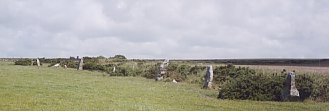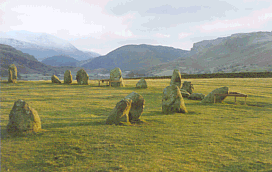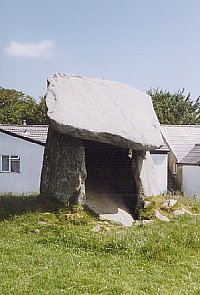Designs In Stone
Though each megalithic site is unique the constructions can be broadly generalised into classes -
| Type | Abbreviation |
|---|---|
| Standing Stone(s) | SS, (SSS) |
| Alignments and Stone rows | SR |
| Stone circles | SC |
| Cromlechs/Dolmens | DO |
| Barrows, Cairns, Allee-couvertes or 'burial chambers' |
BA |
| Henges | HE |
Standing Stones
The archetypal standing stone. These are the most difficult to put into an archaeological context - often they may be the last remnant of an alignment or circle, but some do seem to have been put there to mark a site, standing engimatically through the passing centuries.
Sometimes a single standing stone can form an alignment with a distant feature of the horizon. It is worth remembering that the modern horizon is probably very different from the prehistoric one when looking for suitable features...
Alignments, Stone Rows
 Perhaps
the best known stone rows are the alignments at Carnac - hundreds
of stones aligned in rows. Rows can sometimes be found associated
with stone circles - both Avebury and Stonehenge had avenues
leading up to them. The rows can come singly, as in the Nine Maidens row in
Cornwall, or in pairs, like West Kennet Avenue at Avebury, or
the double rows on Dartmoor.
Perhaps
the best known stone rows are the alignments at Carnac - hundreds
of stones aligned in rows. Rows can sometimes be found associated
with stone circles - both Avebury and Stonehenge had avenues
leading up to them. The rows can come singly, as in the Nine Maidens row in
Cornwall, or in pairs, like West Kennet Avenue at Avebury, or
the double rows on Dartmoor.
Pairs of standing stones sometimes stand in isolation, with the evocative feel of the ancient Standing Stones of Celtic mythology. Sometimes these were built as such - but often they are all that remains of a previous stone row.
Stone Circles
 Burl defines a stone circle as "an approximately
circular setting of spaced standing stones which do not act as a
kerb". Construction of this design flourished from 3500BC to
around 1000BC - there are over 900 stone circles in the British
Isles, though there were probably many more. The expansion of
agriculture in the 18th and 19th century meant that there was an
incentive for farmers to destroy the stones, either bury them, or
dragging them away for use in building works - indeed Keiller at
Avebury recovered many stones from local farmers when he restored
part of the Avebury circle.
Burl defines a stone circle as "an approximately
circular setting of spaced standing stones which do not act as a
kerb". Construction of this design flourished from 3500BC to
around 1000BC - there are over 900 stone circles in the British
Isles, though there were probably many more. The expansion of
agriculture in the 18th and 19th century meant that there was an
incentive for farmers to destroy the stones, either bury them, or
dragging them away for use in building works - indeed Keiller at
Avebury recovered many stones from local farmers when he restored
part of the Avebury circle.
Stonehenge is by far the best known stone circle - however it has an exclusive design and the highly shaped stones with the trilithon construction is unique to that site. Stone circles elsewhere in the country tend to be much simpler than the baroque craftsmanship of Stonehenge! Castlerigg in Cumbria is more typical stone circle.
Barrows, Cairns
Cromlechs,Dolmens,Quoits

These are alternative names for similar structures - a large capstone is held aloft on several others. Trethevy Quoit in Cornwall is a fine example. Many visitors wonder how our ancestors raised the capstones onto the supporting sides, not realising that the earthen mound surrounding the uprights has been worn away in many cases. The engineering task is thus made into the easier task of raising the capstone up a long earthen ramp. Still a remarkable feat given the resources of the day, however!
Henge
The henge is a large raised bank of earth, or often a bank and ditch. In sites like Avebury the ditch is on the inside indicating the purpose was not primarily defensive.